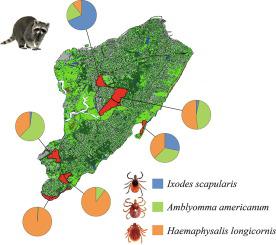International Journal for Parasitology ( IF 3.7 ) Pub Date : 2020-10-29 , DOI: 10.1016/j.ijpara.2020.08.008 Danielle M Tufts 1 , Laura B Goodman 2 , Meghan C Benedict 2 , April D Davis 3 , Meredith C VanAcker 1 , Maria Diuk-Wasser 1

|
Haemaphysalis longicornis, the Asian longhorned tick, is an invasive ixodid tick that has rapidly spread across the northeastern and southeastern regions of the United States since first reported in 2017. The emergence of H. longicornis presents a potential threat for livestock, wildlife, and human health as the host associations and vector potential of this invasive pest in the United States are poorly understood. Previous field data from the United States has shown that H. longicornis was not associated with natural populations of small mammals or birds, but they show a preference for medium sized mammals in laboratory experiments. Therefore, medium and large sized mammals were sampled on Staten Island, New York, United States, to determine H. longicornis host associations and vector potential for a range of human and veterinary pathogens. A total of 97 hosts were sampled and five species of tick (Amblyomma americanum, Dermacentor variabilis, H. longicornis, Ixodes scapularis, Ixodes cookei) were found feeding concurrently on these hosts. Haemaphysalis longicornis was found in the highest proportions compared with other native tick species on raccoons (55.4%), Virginia opossums (28.9%), and white-tailed deer (11.5%). Tissue, blood, and engorged larvae were tested for 17 different pathogens using a nanoscale PCR platform. Infection with five pathogens (Borrelia burgdorferi, Anaplasma phagocytophilum, Rickettsia spp., Mycoplasma haemocanis, and Bartonella spp.) was detected in host samples, but no pathogens were found in any larval samples. These results suggest that although large and medium sized mammals feed large numbers of H. longicornis ticks in the environment, there is presently a low potential for H. longicornis to acquire pathogens from these wildlife hosts.
中文翻译:

美国纽约市侵入性长角血蜱蜱与脊椎动物宿主、其他本地蜱虫载体和蜱传病原体的关联
长角血蜱 ( Haemaphysalis longicornis)是一种入侵性蜱虫,自 2017 年首次报道以来迅速蔓延至美国东北部和东南部地区。长角血蜱的出现对家畜、野生动物和人类构成潜在威胁人们对这种入侵性害虫在美国作为宿主协会的健康状况和媒介潜力知之甚少。先前来自美国的野外数据表明,H. longicornis与小型哺乳动物或鸟类的自然种群无关,但它们在实验室实验中表现出对中型哺乳动物的偏爱。因此,在美国纽约州史泰登岛对中型和大型哺乳动物进行了采样,以确定长角长角龙(H. longicornis)一系列人类和兽医病原体的宿主关联和载体潜力。总共对 97 个宿主进行了采样,发现五种蜱虫( Amblyomma americanum、Dermacentor variabilis、H. longicornis、Ixodes scapularis、Ixodes cookei )同时以这些宿主为食。与浣熊 (55.4%)、弗吉尼亚负鼠 (28.9%) 和白尾鹿 (11.5%) 上的其他本地蜱种相比,长角血蜱的比例最高。使用纳米级 PCR 平台对组织、血液和饱食幼虫进行了 17 种不同病原体检测。感染五种病原体(伯氏疏螺旋体,在宿主样本中检测到嗜吞噬细胞无形体、立克次体属、血液支原体和巴尔通体属),但在任何幼虫样本中均未发现病原体。这些结果表明,尽管大型和中型哺乳动物在环境中以大量长角长角蜱为食,但目前长角长角蜱从这些野生动物宿主身上获得病原体的可能性很低。











































 京公网安备 11010802027423号
京公网安备 11010802027423号